Effect of Sugar Beet Molasses and Compost from Brewery Sludge on Celery (Apium graveolens var. rapaceum) Yield and Nutrient Uptake
Abstract
1. Introduction
2. Materials and Methods
2.1. Climatic Conditions
2.2. Statistical Analysis
3. Results
4. Discussion
5. Conclusions
Author Contributions
Funding
Data Availability Statement
Acknowledgments
Conflicts of Interest
References
- Li, M.Y.; Hou, X.L.; Wang, F.; Tan, G.F.; Xu, Z.S.; Xiong, A.S. Advances in the research of celery, an important Apiaceae vegetable crop. Crit. Rev. Biotechnol. 2017, 38, 172–183. [Google Scholar] [CrossRef] [PubMed]
- Arsenov, D.; Župunski, M.; Pajević, S.; Nemeš, I.; Simin, N.; Alnuqaydan, A.M.; Watson, M.; Aloliqi, A.A.; Mimica-Dukić, N. Roots of Apium graveolens and Petroselinum crispum—Insight into Phenolic Status against Toxicity Level of Trace Elements. Plants 2021, 10, 1785. [Google Scholar] [CrossRef] [PubMed]
- Milić, A.; Adamović, B.; Nastić, N.; Tepić Horecki, A.; Pezo, L.; Šumić, Z.; Pavlić, B.; Živanov, M.; Pavković, N.; Vojnović, Đ. Cluster and Principal Component Analyses of the Bioactive Compounds and Antioxidant Activity of Celery (Apium graveolens L.) Under Different Fertilization Schemes. Foods 2024, 13, 3652. [Google Scholar] [CrossRef]
- Domagała-Świątkiewicz, I.; Gąstoł, M. Comparative study on mineral content of organic and conventional carrot, celery and red beet juices. Acta Sci. Pol. Hortorum Cultus 2012, 11, 173–183. [Google Scholar]
- Babalar, M.; Daneshvar, H.; Diaz-Pérez, J.C.; Nambeesan, S.; Tabrizi, L.; Delshad, M. Effects of organic and chemical nitrogen fertilization and postharvest treatments on the visual and nutritional quality of fresh-cut celery (Apium graveolens L.) during storage. Food Sci. Nutr. 2023, 11, 320–333. [Google Scholar] [CrossRef]
- Adamović, B.; Cabilovski, R.; Vojnović, Đ.; Ilin, Ž. Effect of mulching on nutrient uptake and efficiency of fertilizers in mid-early cabbage production. Acta Sci. Pol. Hortorum Cultus 2023, 22, 69–80. [Google Scholar] [CrossRef]
- Şanli, A.; Kardoĝan, T.; Tosun, B. The Effects of Sugar Beet Molasses Applications on Root Yield and Sugar Content of Sugar Beet (Beta vulgaris L.). Tarla Bitk. Merk. Araştırma Enst. Derg. 2015, 24, 103–108. [Google Scholar] [CrossRef][Green Version]
- Abofard, M.M.; Gaber, A.A.M.; Abdel-Mogib, M.; Mahmoud, N.; Bakr, M.N.; Elwafa, S.F.A. Effect of the application of molasses and vinasses on the yield and quality of sugar beet and soil fertility. Egypt. Sugar J. 2021, 17, 23–40. [Google Scholar] [CrossRef]
- Wynne, A.T.; Meyer, J.H. An Economic assessment of using molasses and condensed molasses solids as a fertilizer in the South African sugar industry. In Proceedings of the 76th Annual Congress of the South Afrian Sugar Technologists Association, Mount Edgecombe, South Africa, 30 July–2 August 2002; Volume 76, pp. 71–78. [Google Scholar]
- Pyakurel, A.; Dahal, B.R.; Rijal, S. Effect of Molasses and Organic Fertilizer in Soil fertility and Yield of Spinach in Khotang, Nepal. Int. J. Appl. Sci. Biotechnol. 2019, 7, 49–53. [Google Scholar] [CrossRef]
- Bortnik, A.; Bortnik, T.; Gavryliuk, V. Efficiency of molasses waste when growing potatoes (Solanum tuberosum) as a new promising organic fertilizer. Agroecol. J. 2023, 1, 110–117. [Google Scholar] [CrossRef]
- Nadeeka, P.W.M.; Seran, T.H. The effects of goat manure and sugarcane molasses on the growth and yield of beetroot (Beta vulgaris L.). J. Agric. Sci. 2020, 65, 321–335. [Google Scholar] [CrossRef]
- Ahmed, A.; Mohammed, M.; Merga, B. Effects of brewery waste sludge on haricot bean (Phaseolus vulgaris L.) productivity and soil fertility. Cogent Food Agric. 2019, 5, 1. [Google Scholar] [CrossRef]
- Stocks, C.; Barker, A.J.; Guy, S. The Composting of Brewery Sludge. J. Inst. Brew. 2002, 108, 452–458. [Google Scholar] [CrossRef]
- Dolgen, D.; Alpaslan, M.N.; Delen, N. Agricultural recycling of treatment-plant sludge: A case study for a vegetable–processing factory. J. Environ. Manag. 2007, 84, 274–281. [Google Scholar] [CrossRef]
- Cristina, G.; Camelin, E.; Pugliese, M.; Tommasi, T.; Fino, D. Evaluation of anaerobic digestates from sewage sludge as a potential solution for improvement of soil fertility. Waste Manag. 2019, 99, 122–134. [Google Scholar] [CrossRef] [PubMed]
- Alayu, E.; Leta, S. Brewery sludge quality, agronomic importance and its short-term residual effect on soil properties. Int. J. Environ. Sci. Technol. 2020, 17, 2337–2348. [Google Scholar] [CrossRef]
- Council Directive of 12 December 1991 Concerning the Protection of Waters Against Pollution Caused by Nitrates from Agricultural Sources (91/676/EEC). Available online: https://eur-lex.europa.eu/legal-content/EN/TXT/?uri=CELEX%3A01991L0676-20081211 (accessed on 9 April 2025).
- Belić, M.; Nešić, L.; Ćirić, V. Pedology Practicum; Agriculture Faculty: Novi Sad, Serbia, 2014; p. 67. Available online: http://polj.uns.ac.rs/sites/default/files/udzbenici/PRAKTIKUM-IZ-PEDOLOGIJE.pdf (accessed on 9 April 2025).
- Enger, H.; Riehm, H.; Domingo, W.R. Studies on the chemical soil analysis as a basis for assessing the nutrient status of soils. II Chemical extraction methods for phosphorus and potassium determination. Kungl. Lantbr. Högsk. Ann. 1960, 26, 199. (In German) [Google Scholar]
- ISO 10390; Soil, Treated Biowaste and Sludge—Determination of pH. International Organization for Standardization: Geneva, Switzerland, 2021.
- ICUMSA Method GS4-22 (2002); The Determination of Sucrose and Betaine by HPLC in Beet Molasses—Official. International Commission for Uniform Methods of Sugar Analysis: Grünstadt, Germany, 2002.
- ICUMSA Method GS4-13 (2009); The Determination of Refractometric Dry Substance (RDS) of Molasses—Accepted and Very Pure Syrups (Liquid Sugars), Thick Juice and Run-Off Syrups—Official. International Commission for Uniform Methods of Sugar Analysis: Grünstadt, Germany, 2009.
- Ragonezi, C.; Nunes, N.; Oliveira, M.C.O.; de Freitas, J.G.R.; Ganança, J.F.T.; de Carvalho, M.Â.A.P. Sewage Sludge Fertilization—A Case Study of Sweet Potato Yield and Heavy Metal Accumulation. Agronomy 2022, 12, 1902. [Google Scholar] [CrossRef]
- Nicoletto, C.; Santagata, S.; Zanin, G.; Sambo, P. Effect of the anaerobic digestion residues use on lettuce yield and quality. Sci. Hortic. 2014, 180, 207–213. [Google Scholar] [CrossRef]
- Silva, M.B.; Camargos, L.S.; Teixeira Filho, M.C.M.; Souza, L.A.; Coscione, A.R.; Lavres, J.; Abreu-Junior, C.H.; He, Z.; Zhao, F.; Jani, A.D.; et al. Residual effects of composted sewage sludge on nitrogen cycling and plant metabolism in a no-till common bean-palisade grass-soybean rotation. Front. Plant Sci. 2023, 14, 1281670. [Google Scholar] [CrossRef]
- Navarro, A.S.; Romero, J.A.S.; Sanjuan, M.C.S.; Bernardeau, M.A.B.; Iniesta, M.J.D. Medium-Term Influence of Organic Fertilization on the Quality and Yield of a Celery Crop. Agronomy 2020, 10, 1418. [Google Scholar] [CrossRef]
- Abou El-Magd, M.M.; El-Bassiony, A.M.; Fawzy, Z.F. Effect of organic manure with or without chemical fertilizer on growth, yield and quality of some varieties of broccoli plants. J. Appl. Sci. Res. 2006, 2, 791–798. [Google Scholar]
- Citak, S.; Sonmez, S. Influence of Organic and Conventional Growing Conditions on the Nutrient Contents of White Head Cabbage (Brassica oleracea var. capitata) during Two Successive Seasons. J. Agric. Food Chem. 2010, 58, 1788–1793. [Google Scholar] [CrossRef] [PubMed]
- Mukai, S.; Oyanagi, W. Decomposition characteristics of indigenous organic fertilisers and introduced quick compost and their short-term nitrogen availability in the semi-arid Ethiopian Rift Valley. Sci. Rep. 2019, 9, 16000. [Google Scholar] [CrossRef] [PubMed]
- Bonanomi, G.; De Filippis, F.; Zotti, M.; Idbella, M.; Cesarano, G.; Al-Rowaily, S.; Abd-El Gawad, A. Repeated applications of organic amendments promote beneficial microbiota, improve soil fertility and increase crop yield. Appl. Soil Ecol. 2020, 156, 103714. [Google Scholar] [CrossRef]
- Goyal, S.; Chander, K.; Mundra, M.C.; Kapoor, K.K. Influence of inorganic fertilizers and organic amendments on soil organic matter and soil microbial properties under tropical conditions. Biol. Fertil. Soils 1999, 29, 196–200. [Google Scholar] [CrossRef]
- Al-Dhumri, S.A.; Al Mosallam, M.S.; Zhang, W.; Alharabi, S.; Abou-Elwafa, S.F. Application of Molasses as an Eco-Innovative Approach Substitutes Mineral Nitrogen Fertilization and Enhances Sugar Beet Productivity. Waste Biomass Valorization 2023, 14, 287–296. [Google Scholar] [CrossRef]
- Honma, T.; Kaneko, A.; Ohba, H.; Ohyama, T. Effect of application of molasses to paddy soil on the concentration of cadmium and arsenic in rice grain. Soil Sci. Plant Nutr. 2012, 58, 255–260. [Google Scholar] [CrossRef]
- Godlewska, K.; Pacyga, P.; Michalak, I.; Biesiada, A.; Szumny, A.; Pachura, N.; Piszcz, U. Field-Scale Evaluation of Botanical Extracts Effect on the Yield, Chemical Composition and Antioxidant Activity of Celeriac (Apium graveolens L. Var. rapaceum). Molecules 2020, 25, 4212. [Google Scholar] [CrossRef]
- Saleh, S.; Liu, G.; Liu, M.; Liu, W.; He, H.; Abdelhamid, M.T. Do NH4:NO3 ratio and harvest time affect celery (Apium graveolens) productivity and product quality? Folia Hortic. 2019, 31, 343–353. [Google Scholar] [CrossRef]
- Bishop, R.F.; Chlpman, E.W.; MacEachern, C.R. Effect of nitrogen, phosphorus and potassium on yields and nutrient levels in celery and head lettuce grown on sphagnum peat. Commun. Soil Sci. Plant Anal. 1973, 4, 375–387. [Google Scholar] [CrossRef]
- Li, Y.; Wang, T.; Li, J.; Ao, Y. Effect of phosphorus on celery growth and nutrient uptake under different calcium and magnesium levels in substrate culture. Hortic. Sci. 2010, 37, 99–108. [Google Scholar] [CrossRef]
- Golubkina, N.A.; Kharchenko, V.A.; Moldovan, A.I.; Koshevarov, A.A.; Zamana, S.; Nadezhkin, S.; Soldatenko, A.; Sekara, A.; Tallarita, A.; Caruso, G. Yield, Growth, Quality, Biochemical Characteristics and Elemental Composition of Plant Parts of Celery Leafy, Stalk and Root Types Grown in the Northern Hemisphere. Plants 2020, 9, 484. [Google Scholar] [CrossRef]
- Inthichack, P.; Nishimura, Y.; Fukumoto, Y. Effect of Potassium Sources and Rates on Plant Growth, Mineral Absorption, and the Incidence of Tip Burn in Cabbage, Celery, and Lettuce. Hort. Environ. Biotechnol. 2012, 53, 135–142. [Google Scholar] [CrossRef]
- Li, Y.; Qin, J.; Mattson, N.S.; Ao, Y. Effect of potassium application on celery growth and cation uptake under different calcium and magnesium levels in substrate culture. Sci. Hortic. 2013, 158, 33–38. [Google Scholar] [CrossRef]
- Cserni, I.; Hüvely, A.; Petö, J. The impact of potassium fertilization on development and magnesium content of celery. Gradus 2020, 7, 57–61. [Google Scholar] [CrossRef]
- Boateng, S.A.; Zickermann, J.; Kornahrens, M. Poultry manure effect on growth and yield of maize. West Afr. J. Appl. Ecol. 2006, 9, 1–11. [Google Scholar] [CrossRef]
- Taiwo, A.A.; Adetunji, M.T.; Azeez, J.O.; Elemo, K.O. Kinetics of potassium release and fixation in some soils of Ogun State, Southwestern, Nigeria as influenced by organic manure. Int. J. Recycl. Org. Waste Agric. 2018, 7, 251–259. [Google Scholar] [CrossRef]
- Medina, E.; Pardes, C.; Pérez-Murcia, M.D.; Bustamante, M.A.; Moral, R. Spent mushroom substrates as component of growing media for germination and growth of horticultural plants. Bioresour. Technol. 2009, 100, 4227–4232. [Google Scholar] [CrossRef]
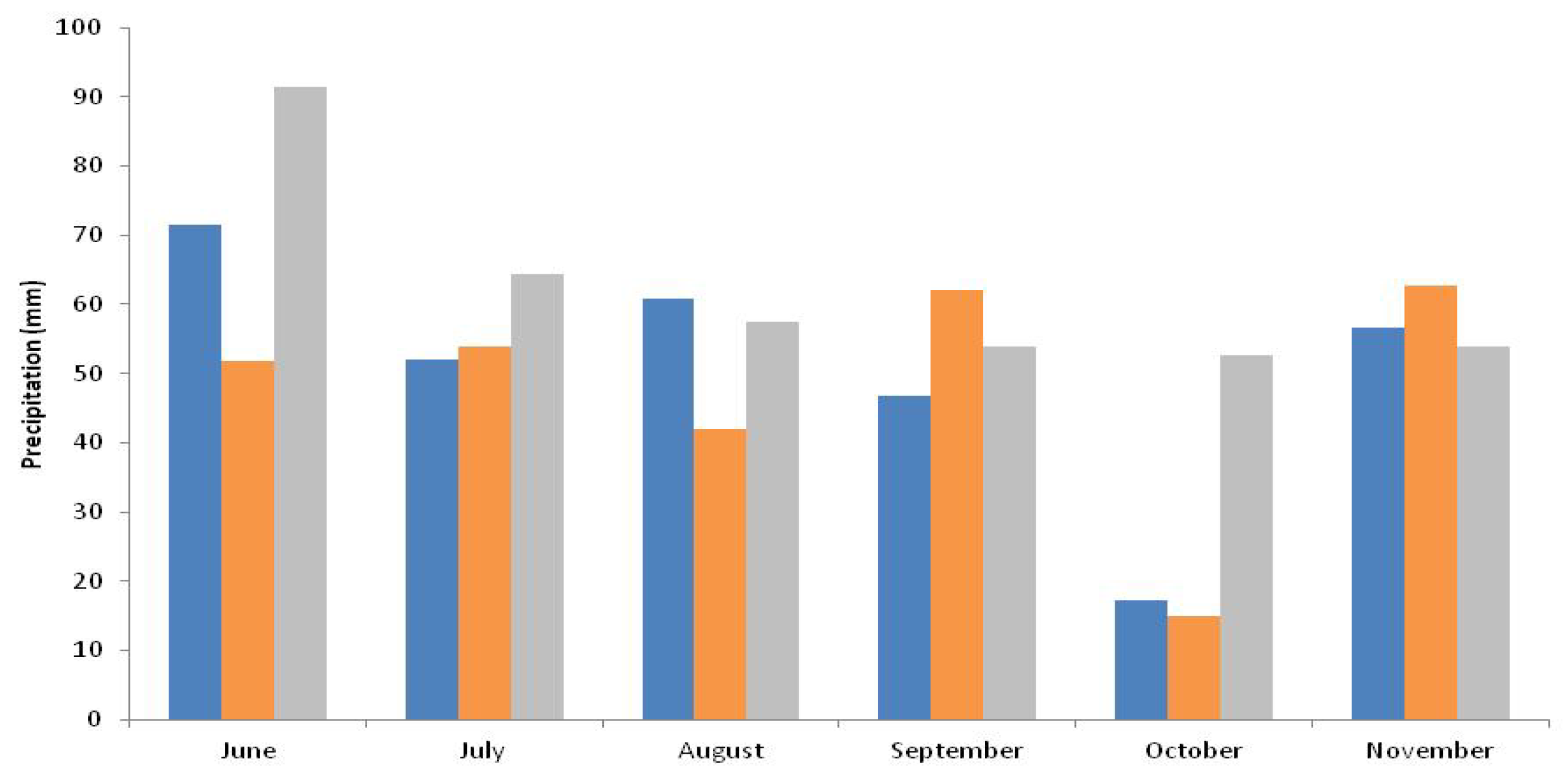
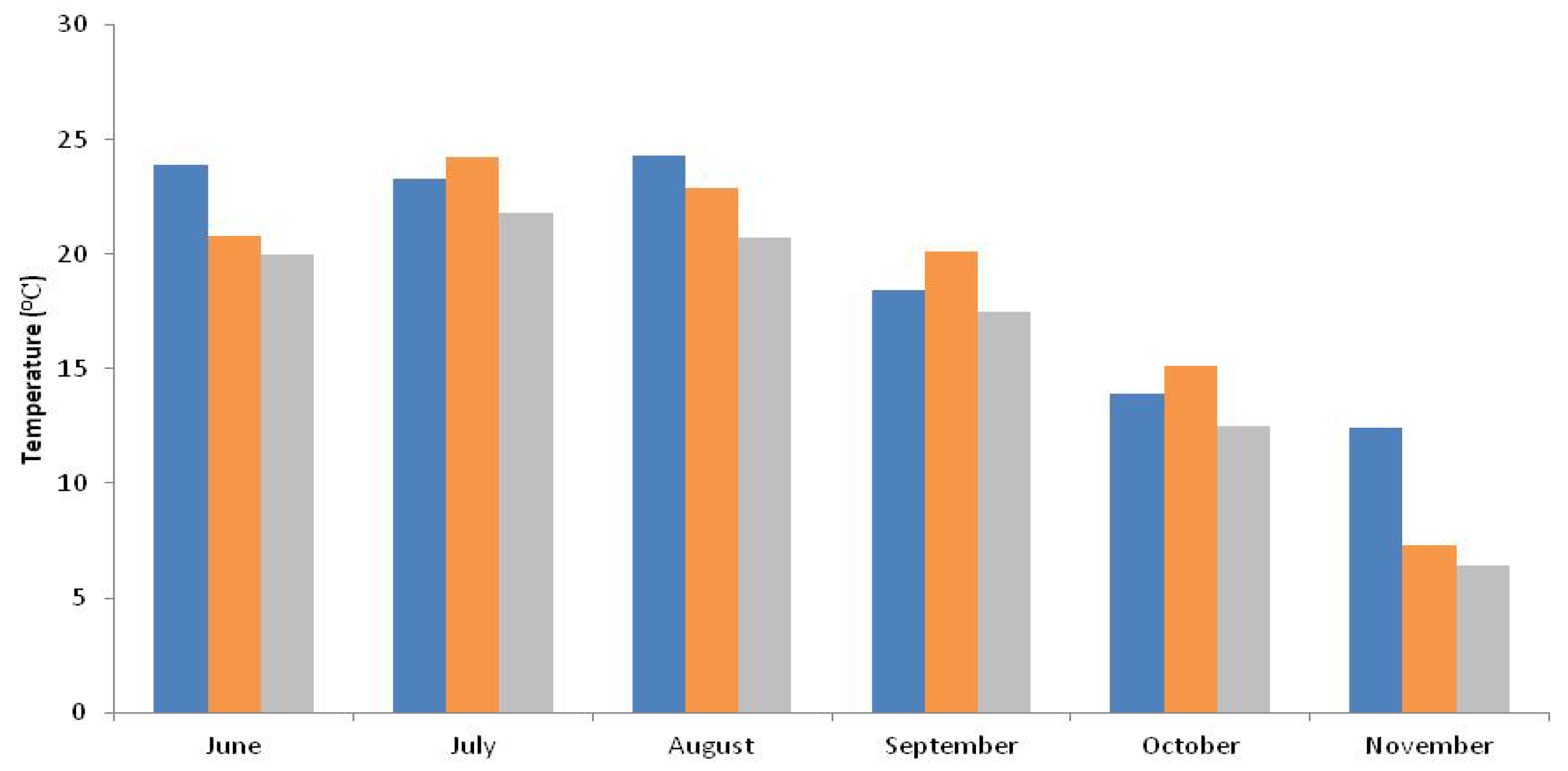
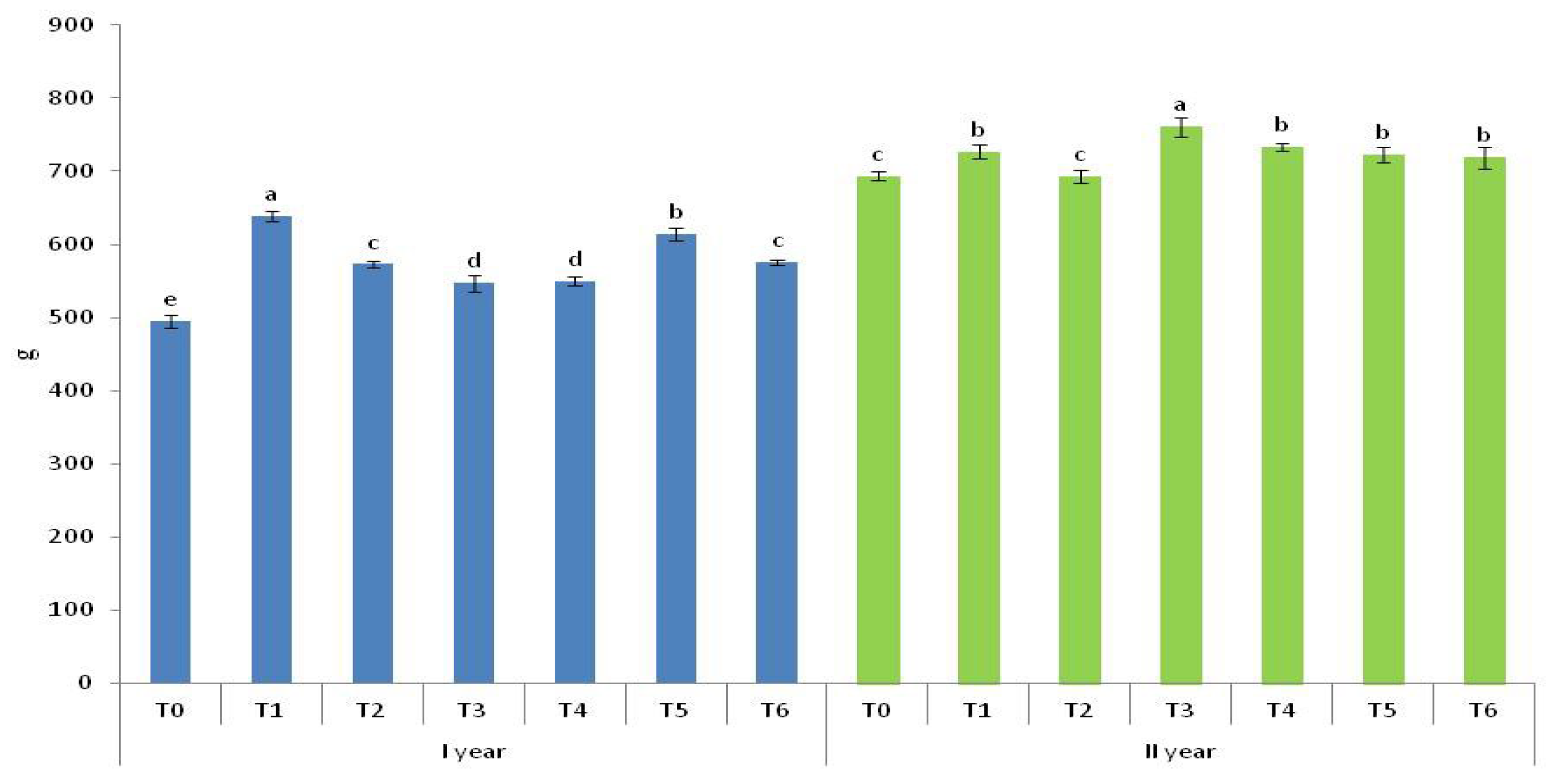


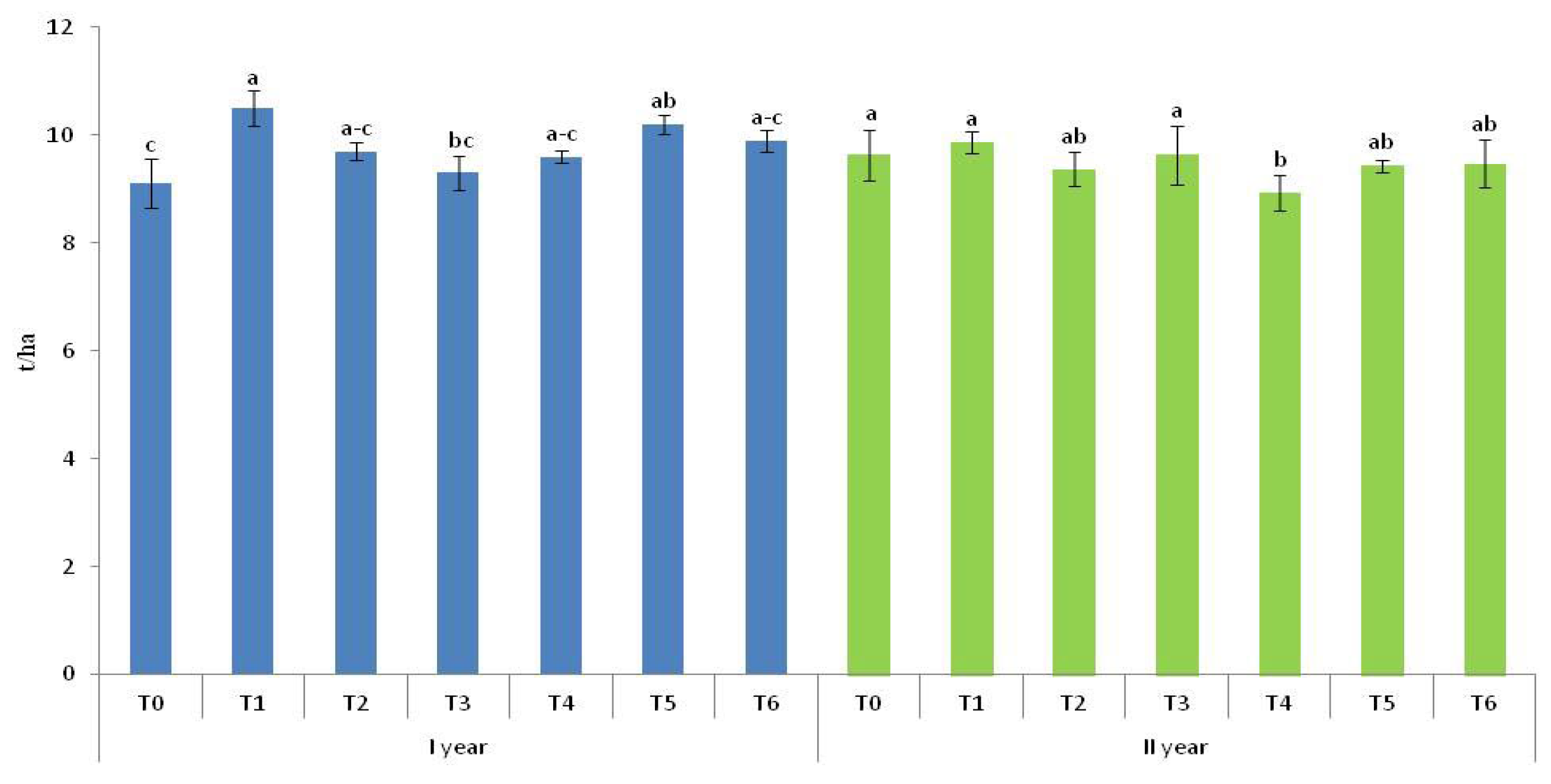
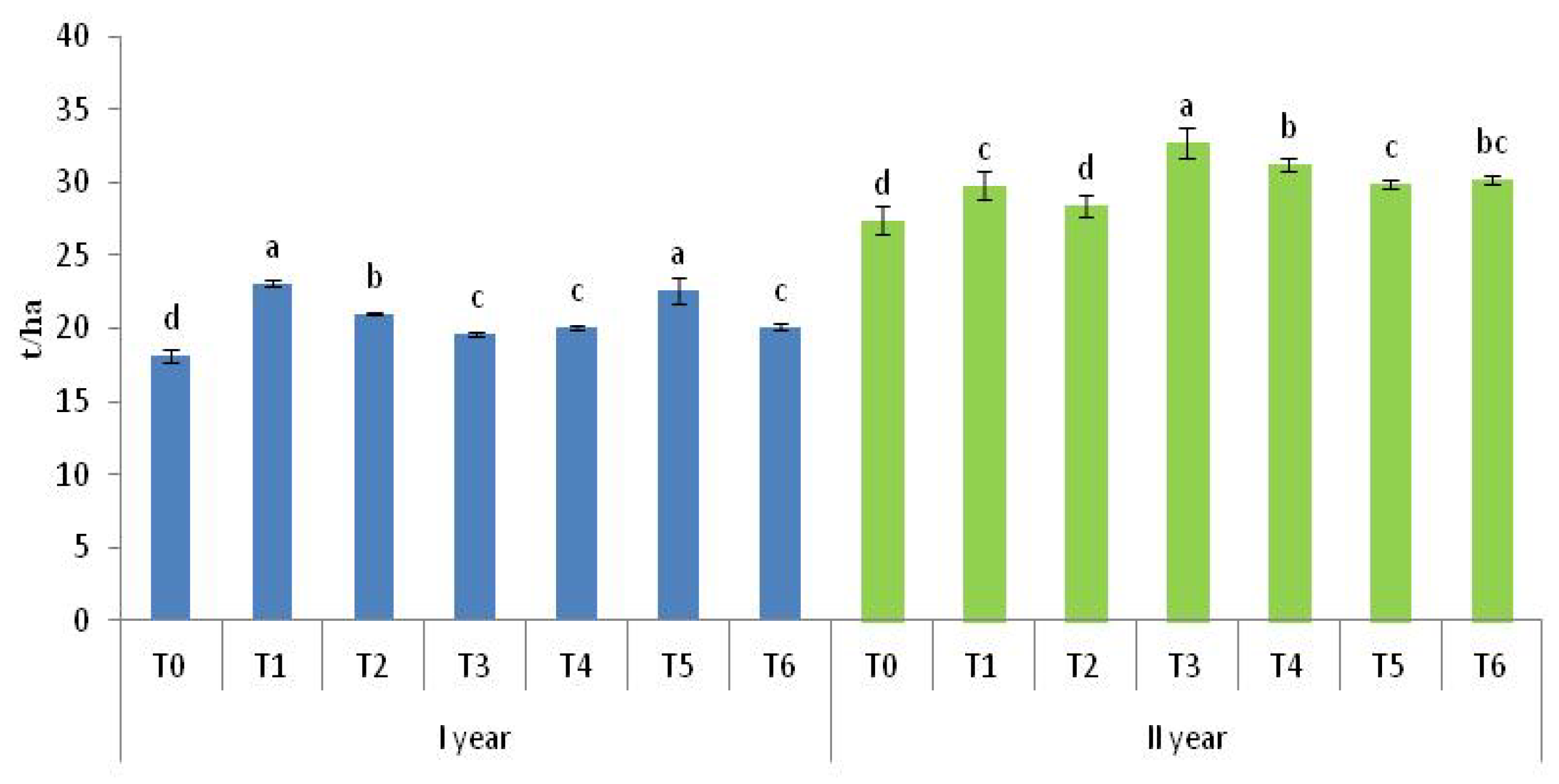
| Variant | First Year | Second Year |
|---|---|---|
| T0 | 0 t/ha | 0 t/ha |
| T1 | 0.8 t/ha NPK 9:12:25 + 0.288 t/ha AN (34% N) | 0.8 t/ha NPK 9:12:25 + 0.288 t/ha AN (34% N) |
| T2 | 18.0 t/ha | 35.2 t/ha |
| T3 | 40 t/ha | 35.2 t/ha |
| T4 | 36.5 t/ha | 21.7 t/ha |
| T5 | 33.9 t/ha | 30.3 t/ha |
| T6 | 8.5 t/ha | 8.5 t/ha |
| Organic Manure | Year | N (%) | P2O5 (%) | K2O (%) | Moisture Content (%) | Organic Matter (%) | Organic C (%) |
|---|---|---|---|---|---|---|---|
| Supercompost | I | 2.21 | 3.05 | 0.13 | 77.29 | 41.71 | 15.19 |
| II | 2.28 | 2.06 | 0.11 | 75.46 | 38.72 | 10.12 | |
| Cattle manure | I | 2.25 | 3.83 | 2.22 | 58.08 | 48.95 | 16.25 |
| II | 2.09 | 1.85 | 2.06 | 76.92 | 71.54 | 18.74 | |
| Sheep manure | I | 1.76 | 1.01 | 2.64 | 75.94 | 67.24 | 24.09 |
| II | 1.79 | 0.97 | 2.54 | 73.03 | 57.73 | 17.02 | |
| Poultry manure | I | 1.00 | 1.56 | 1.69 | 53.45 | 28.02 | 14.90 |
| II | 2.50 | 2.33 | 2.65 | 68.64 | 75.47 | 16.50 |
| N (%) | P2O5 (%) | K2O (%) | Organic C (%) | C/N Ratio | DM |
| 2 | / | 5 | 16.5 | 15 | >48 |
| Sucrose (%) | Raffinose and trisaccharides (%) | Glucose (%) | Fructose (%) | Inositol (%) | pH |
| <12 | <3.5 | <0.5 | <0.15 | <0.5 | 7 |
| Year | pH | CaCO3 (%) | Humus (%) | Total N (%) | Al-P2O5 mg/100 g | Al-K2O mg/100 g | |
|---|---|---|---|---|---|---|---|
| KCL | H2O | ||||||
| I | 7.39 | 8.38 | 6.36 | 2.25 | 0.167 | 13.98 | 19.83 |
| II | 7.27 | 8.06 | 8.64 | 2.05 | 0.10 | 53.74 | 34.61 |
| Organic Manure | Year | N | P2O5 | K2O |
|---|---|---|---|---|
| Supercompost | I | 170 | 235 | 10 |
| II | 170 | 153 | 8 | |
| Cattle manure | I | 170 | 289 | 168 |
| II | 170 | 150 | 168 | |
| Sheep manure | I | 170 | 97 | 254 |
| II | 170 | 92 | 241 | |
| Poultry manure | I | 170 | 265 | 287 |
| II | 170 | 159 | 180 | |
| Molasess | I | 170 | 0 | 425 |
| II | 170 | 0 | 425 |
| Variants | N | P2O5 | K2O | CaO | |
|---|---|---|---|---|---|
| I year | T0 | 25.5 e | 52.9 d | 44.0 d | 41.5 b |
| T1 | 42.0 a | 58.5 c | 62.5 c | 44.0 a | |
| T2 | 32.7 c | 67.0 b | 77.7 a | 39.5 b | |
| T3 | 31.1 cd | 66.1 b | 66.9 b | 33.4 c | |
| T4 | 29.5 d | 68.4 b | 70.4 b | 31.0 d | |
| T5 | 38.5 b | 73.1 a | 67.9 b | 34.6 c | |
| T6 | 31.1 cd | 68.2 b | 76.7 a | 33.2 c | |
| Average | 32.9 | 64.9 | 66.6 | 36.7 | |
| SD | 5.6 | 6.9 | 11.3 | 4.9 | |
| II year | T0 | 36.7 e | 76.1 e | 63.3 d | 59.7 a |
| T1 | 51.2 a | 71.4 f | 76.2 c | 53.7 b | |
| T2 | 39.0 d | 79.8 d | 92.5 b | 47.1 c | |
| T3 | 44.2 b | 93.8 b | 94.9 b | 47.4 c | |
| T4 | 43.6 b | 101.2 a | 104.1 a | 45.8 cd | |
| T5 | 44.0 b | 83.6 c | 77.6 c | 39.6 e | |
| T6 | 41.4 c | 90.5 b | 101.8 a | 44.0 d | |
| Average | 42.9 | 85.2 | 87.2 | 48.2 | |
| SD | 4.6 | 10.5 | 15.11 | 6.6 |
| Variants | N | P2O5 | K2O | CaO | |
|---|---|---|---|---|---|
| I year | T0 | 28.1 cd | 14.6 bc | 26.5 c | 41.2 d |
| T1 | 32.3 ab | 17.6 a | 35.4 a | 46.8 c | |
| T2 | 30.0 bc | 16.3 ab | 30.7 b | 44.9 cd | |
| T3 | 28.6 b-d | 14.1 c | 22.2 d | 41.9 cd | |
| T4 | 34.4 a | 16.9 a | 23.6 cd | 60.1 ab | |
| T5 | 29.9 bc | 16.8 a | 15.9 e | 65.1 a | |
| T6 | 25.0 d | 16.1 ab | 21.4 d | 56.1 b | |
| Average | 29.8 | 16.1 | 25.1 | 50.9 | |
| SD | 3.0 | 1.3 | 6.4 | 9.5 | |
| II year | T0 | 31.5 ab | 16.3 a | 29.6 b | 46.1 cd |
| T1 | 30.4 bc | 16.6 a | 33.4 a | 44.1 d | |
| T2 | 29.4 c | 16.0 a | 30.0 b | 44.0 d | |
| T3 | 32.3 a | 16.0 a | 25.2 c | 47.4 c | |
| T4 | 30.5 bc | 15.0 b | 20.9 d | 53.2 b | |
| T5 | 26.1 d | 14.6 b | 13.8 e | 56.7 a | |
| T6 | 25.0 d | 16.1 a | 21.4 d | 56.1 a | |
| Average | 29.3 | 15.8 | 24.9 | 49.7 | |
| SD | 2.8 | 0.7 | 6.7 | 5.5 |
Disclaimer/Publisher’s Note: The statements, opinions and data contained in all publications are solely those of the individual author(s) and contributor(s) and not of MDPI and/or the editor(s). MDPI and/or the editor(s) disclaim responsibility for any injury to people or property resulting from any ideas, methods, instructions or products referred to in the content. |
© 2025 by the authors. Licensee MDPI, Basel, Switzerland. This article is an open access article distributed under the terms and conditions of the Creative Commons Attribution (CC BY) license (https://creativecommons.org/licenses/by/4.0/).
Share and Cite
Adamović, B.; Vojnović, Đ.; Maksimović, I.; Putnik Delić, M.; Kovačević, D.; Čabilovski, R.; Živanov, M.; Ignjatov, M.; Červenski, J.; Latković, D. Effect of Sugar Beet Molasses and Compost from Brewery Sludge on Celery (Apium graveolens var. rapaceum) Yield and Nutrient Uptake. Horticulturae 2025, 11, 836. https://doi.org/10.3390/horticulturae11070836
Adamović B, Vojnović Đ, Maksimović I, Putnik Delić M, Kovačević D, Čabilovski R, Živanov M, Ignjatov M, Červenski J, Latković D. Effect of Sugar Beet Molasses and Compost from Brewery Sludge on Celery (Apium graveolens var. rapaceum) Yield and Nutrient Uptake. Horticulturae. 2025; 11(7):836. https://doi.org/10.3390/horticulturae11070836
Chicago/Turabian StyleAdamović, Boris, Đorđe Vojnović, Ivana Maksimović, Marina Putnik Delić, Dragan Kovačević, Ranko Čabilovski, Milorad Živanov, Maja Ignjatov, Janko Červenski, and Dragana Latković. 2025. "Effect of Sugar Beet Molasses and Compost from Brewery Sludge on Celery (Apium graveolens var. rapaceum) Yield and Nutrient Uptake" Horticulturae 11, no. 7: 836. https://doi.org/10.3390/horticulturae11070836
APA StyleAdamović, B., Vojnović, Đ., Maksimović, I., Putnik Delić, M., Kovačević, D., Čabilovski, R., Živanov, M., Ignjatov, M., Červenski, J., & Latković, D. (2025). Effect of Sugar Beet Molasses and Compost from Brewery Sludge on Celery (Apium graveolens var. rapaceum) Yield and Nutrient Uptake. Horticulturae, 11(7), 836. https://doi.org/10.3390/horticulturae11070836







